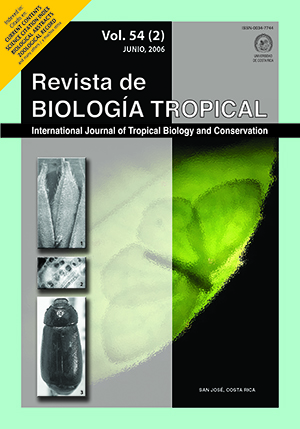Abstract
Lepidoptera species were monitored in a plantation of Eucalyptus grandis in the Municipality of
Bom Despacho, State of Minas Gerais, Brazil from March 1987 to February 1992. A total of 547 species
were collected and divided in: primary pests: 13; secondary pests: 20; species without defined importance to
eucalyptus: 79; and non-identified species: 435. These four groups had a mean of 5231.29; 338.18; 438.16 and
2222.87 individuals with a total of 8229.87 individuals collected per trap. The number of species without defined
importance to eucalyptus, and non-identified species, increased during the collecting period of five years while
those of primary and secondary pests showed similar numbers in all years. The most collected primary pests
Thyrinteina arnobia Stoll and Stenalcidia sp. (Geometridae) showed higher frequencies during the driest and
coldest periods of the year, whereas Psorocampa denticulata Schaus (Notodontidae) was most frequent during
periods of higher rainfall. Species of groups III and IV increased in diversity with eucalyptus age. This area
has a high probability of outbreaks of eucalyptus defoliating caterpillars, especially T. arnobia. For this reason,
lepidopteran pests should be monitored in this plantation during the driest and coldest periods of the year, when
they can reach population peaks.
##plugins.facebook.comentarios##

This work is licensed under a Creative Commons Attribution 4.0 International License.
Copyright (c) 2006 Revista de Biología Tropical






